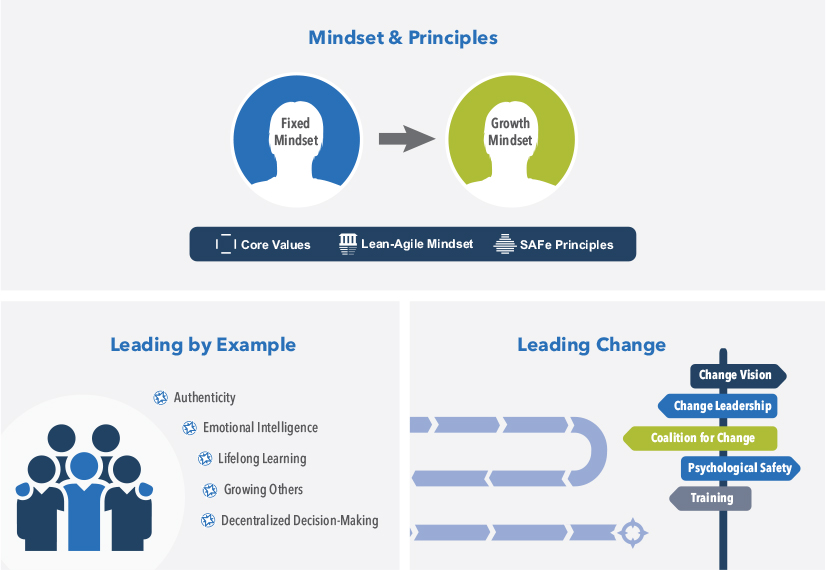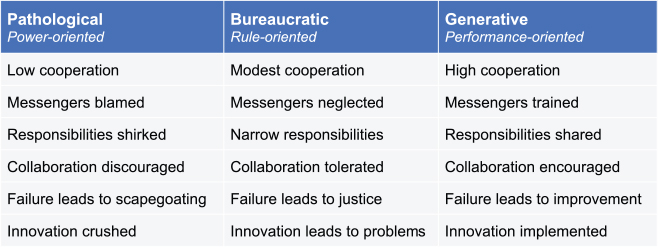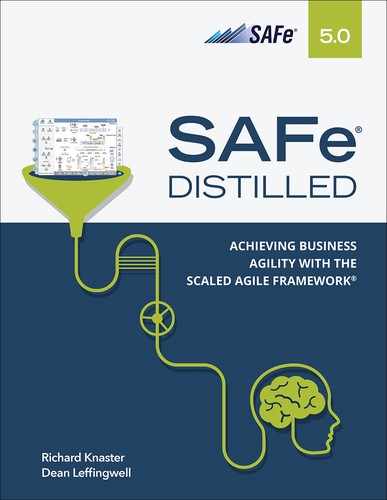5
Lean-Agile Leadership
It is not enough that top management commit themselves for life to quality and productivity. They must know what it is that they are committed to—that is, what they must do. These obligations cannot be delegated. Support is not enough: action is required.
—W. Edwards Deming, Out of Crisis
The Lean-Agile leadership competency describes how Lean-Agile leaders drive and sustain organizational change and operational excellence by empowering individuals and teams to reach their highest potential. Leading by example, these leaders learn and model the Scaled Agile Framework (SAFe) Lean-Agile mindset, values, principles, and practices. They lead the change to the new way of working.
Why Lean-Agile Leaders?
An organization’s managers and leaders are responsible for the adoption, success, and continuous improvement of Lean-Agile development and for fostering the competencies that lead to business agility. Only they have the authority to change and continuously improve the systems that govern how work is done. Only these leaders can create an environment that supports high-performing Agile teams that quickly produce value and improve continuously. Therefore, leaders need to internalize and model leaner ways of thinking and operating so teams will learn from their example.
Business agility requires a different approach to leadership. It starts with leaders exemplifying the Lean and Agile principles and behaviors that will inspire and motivate the organization to pursue a better way of working. Leaders set the example through coaching, empowering, and engaging individuals and teams to reach their highest potential.
In short, knowledge alone is not enough. Lean-Agile leaders need to do more than support the transformation. They actively lead the change and guide the activities necessary to understand and continuously optimize the flow of value through the enterprise.
By helping leaders develop their knowledge and skills based on the three dimensions shown in Figure 5-1, organizations can establish Lean-Agile leadership as the foundational core competency.

Figure 5-1. The dimensions of Lean-Agile leadership
These dimensions are as follows:
Mindset and principles. By embedding the Lean-Agile way of working in their beliefs, decisions, responses, and actions, leaders model the expected norms throughout the organization.
Leading by example. Leaders gain earned authority by modeling the desired behaviors for others to follow, inspiring them to incorporate the leader’s example into their own personal development.
Leading change. By creating the right environment, leaders are actively engaged in the transformation, rather than simply supporting it. They prepare the people and provide the necessary resources to realize the desired outcomes.
The following sections explore the three dimensions of Lean-Agile leadership.
Mindset and Principles
“The basic tenets of Lean challenge many of the aspects of traditional management theory and call for a mindset that is foreign to most executives.”
—Jacob Stoller, author of The Lean CEO: Leading the Way to World-Class Excellence
Mindset and principles is the first dimension of Lean-Agile leadership competency. Stoller’s quote reminds us that traditional management practices cannot accommodate the changes needed to achieve business agility. Instead, the Lean enterprise depends on what Toyota calls ‘Lean-thinking manager-teachers.’ These leaders understand Lean thinking and SAFe principles and teach them to others. It is integral to who they are and what they do.
When leaders routinely refer to these values and principles and make them part of their coaching and mentoring, it reinforces the new mindset as the way of thinking and behaving.
Chapter 3, Lean-Agile Mindset, described the criticality of the new mindset and how it provides the foundation for adopting and applying SAFe principles and practices and how it supports an enhanced company culture that enables business agility. Further, we noted the awareness and importance of a growth mindset, which requires a belief that new abilities can be developed with time and effort. In turn, this opens leaders to the possibility that existing mindsets can and need to evolve to guide the needed organizational change.
Chapter 4, SAFe Principles, described the 10 immutable, underlying Lean-Agile principles. These tenets and economic concepts inspire and inform the roles and practices of SAFe.
Leading the transformation needed to achieve business agility requires a mindset based on the core values and principles of Lean, Agile, and SAFe (Figure 5-2).

Figure 5-2. Lean-Agile mindset and the core values and principles of SAFe
Next, we will cover one last aspect of the mindset and principles dimension: the four core values of SAFe, which represent the fundamental beliefs that are key to SAFe’s effectiveness.
SAFe Core Values
The four core values that define SAFe’s essential ideals and beliefs are alignment, transparency, built-in quality, and program execution. Leaders play a critical role in communicating, exhibiting, and emphasizing them, which helps guide the organization on its mission.
The following are some tips leaders can use to reinforce these values:
Alignment. Communicate the mission by establishing and expressing the portfolio strategy and solution vision. Help organize the value stream and coordinate dependencies. Provide relevant briefings and participate in Program Increment (PI) planning. Help with backlog visibility, review, and preparation; regularly check for understanding.
Built-in quality. By refusing to accept or ship low-quality work, Lean-Agile leaders demonstrate their commitment to quality. They support investments in capacity planning for maintenance and to reduce technical debt. This ensures that the quality concerns of the entire organization are part of the regular flow of work, including design thinking, user experience, architecture, operations, security, and compliance.
Transparency. Visualize all relevant work. Take ownership and responsibility for errors and mistakes. Admit missteps while supporting others who acknowledge and learn from theirs. Never punish the messenger. Instead, celebrate learning. Create an environment where the facts are always friendly and transparent.
Program execution. Participate as Business Owners in PI execution and establish business value. Help adjust the scope to ensure demand matches capacity. Celebrate high-quality program increments while aggressively removing impediments and demotivators.
Each core value is critical to experiencing the personal and business benefits of SAFe. Moreover, the core values, mindset, and principles work together as a system. Lean-Agile leaders embrace these values and principles and routinely demonstrate and apply them as they carry out their responsibilities, as discussed in the next section.
Leading by Example
“Setting an example is not the main means of influencing others; it is the only means.”
—Albert Einstein
The second dimension of the Lean-Agile leadership competency is leading by example. Through their words and actions, a leader’s behavior greatly influences the organization’s culture, for better or worse. The most effective way to transform into a Lean enterprise is for leaders to internalize and then model the right behaviors and mindsets of business agility so that others can learn and grow by example.
In his book Leaders Eat Last, author Simon Sinek underscores this concept with the following excerpt:
“The leaders of companies set the tone and direction for the people. Hypocrites, liars, and self-interested leaders create cultures filled with hypocrites, liars, and self-interested employees. The leaders of companies who tell the truth, in contrast, will create a culture of people who tell the truth. It is not rocket science. We follow the leader.”1
1. Simon Sinek, Leaders Eat Last, Kindle edition (Penguin Random House, 2014)
Leaders set the tone for the company’s culture and recognize that a positive culture is an important mechanism for attracting, motivating, and retaining talented employees; it may be the single best predictor of organizational excellence. It’s more fun, too. One long-term study discovered that organizations with strong cultures outperform those with weak cultures two to one.2
2. Robert Daft, The Leadership Experience, 7th edition (Cengage Learning, 2017).
Sociologist Ron Westrum believed that organizational culture was a predictor of safety and performance outcomes in the healthcare industry.3 He classified cultures into three types of organizations.
Pathological (power-oriented). These organizations are characterized by low cooperation across groups and a culture of blame. Information is often withheld for personal gain.
Bureaucratic (rule-oriented). Bureaucratic cultures are overly preoccupied with rules and position, and responsibilities are compartmentalized by the department, with little concern for the overall mission of the organization.
Generative (performance-oriented). The hallmarks of a generative organization are good information flow, high cooperation and trust, bridging between teams, and conscious inquiry.
3. https://cloud.google.com/solutions/devops/devops-culture-westrum-organizational-culture.
So, it follows that by modeling the right behaviors, leaders can influence the organization’s culture from pathological and bureaucratic to a generative culture, which enables the Lean-Agile mindset to flourish and spread.
Figure 5-3 provides a comparison of Westrum’s cultural model and defines its three archetypes.4
4. Robert Daft, The Leadership Experience, 7th edition (Cengage Learning, 2017).

Figure 5-3 Westrum’s organizational culture model (adapted)5
5. Ron Westrum, “A topology of organisational cultures,” BMJ Quality & Safety 2004; 13: ii22–ii27.
This raises the next important question: what, then, are the behaviors for leaders to embrace to set the right example to build a generative culture? Although the list could be quite long, the following characteristics offer a good starting point to successfully guide the organization to a generative culture:
Authenticity is when leaders act with honesty, integrity, and transparency, remaining true to themselves and their beliefs.
Emotional intelligence is how leaders manage their emotions and those of others through self-awareness, self-regulation, motivation, empathy, and social skills.
Lifelong learning enables leaders to engage in an ongoing, voluntary, and self-motivated pursuit of knowledge and growth, while encouraging and supporting others to do the same.
Growing others helps leaders provide the personal, professional, and technical guidance and resources each employee needs to assume increasing levels of responsibility and decision-making.
Decentralized decision-making takes decision authority and moves it down to the people with the information. This requires investing in the team’s technical competence and providing organizational clarity with decision guardrails.6
6. David Marquet. Turn the Ship Around, Kindle edition (Penguin Group, 2013).
These same behaviors also build earned authority—power gained through trust, respect, expertise, or act. This engenders greater engagement and commitment to organizational aims than sheer positional authority. Such leaders inspire others to follow their direction and to incorporate the leader’s example into their own personal development journey. This is a key element of Leading Change, which is described next.
Leading Change
“Nothing undermines change more than behavior by important individuals that is inconsistent with the verbal communication.”
—John P. Kotter, Leading Change
Leading change is the third dimension of the Lean-Agile leadership competency. Becoming a Lean-thinking manager-teacher provides leaders with the thought processes and practical tools they’ll need to start building the Lean enterprise and achieving business agility. The benefits of delivering value in the shortest sustainable lead time, creating flow, and producing customer delight—all with happy, engaged employees— are clear. It’s also clear that for many organizations, the new way of working represents a powerful shift in culture and practice from past paradigms.
Successful organizational change requires leaders to lead the transformation rather than simply support it. They create the environment, prepare the people, and provide the necessary resources to realize the desired outcomes.
In fact, research shows clear correlations between the leader behaviors described in the ‘Leading by Example’ section of this chapter and the success of organizational change driven by Agile, Lean, and DevOps initiatives. Other researchers found that these leader behaviors have a greater influence on an employee’s commitment to support the change, rather than simply following a prescriptive change model.7, 8
7. Stephen Mayner. Transformational leadership and organizational change during Agile and DevOps initiatives (ProQuest, 2017).
8. DM Herold, DB Fedor, S Caldwell, and Y Liu, “The effects of transformational and change leadership on employees’ commitment to change: a multi-level study.” Journal of Applied Psychology, vol. 93 (2008): pp. 346–357.
By developing and applying the following skills and techniques, Lean-Agile leaders drive the change process in the following ways:
Change vision occurs when leaders communicate why change is needed and do so in ways that inspire, motivate, and engage people.
Change leadership is the ability to positively influence and motivate others to engage in organizational change through the leader’s personal advocacy and drive.
A powerful coalition for change forms when individuals from multiple levels and across silos are empowered and have influence to effectively lead the change.
Psychological safety occurs when leaders create an environment for risk-taking that supports change without fear of negative consequences to self-image, status, or career.
Training everyone in the new way of working ensures that the whole company learns the values, principles, and practices of Lean and Agile, including a commitment by leaders so they can lead by example.
Clearly, these aspects require the active participation of the leaders driving the change. But even this is not enough. As Dan and Chip Heath note in their book on change,9 leaders “need to script the critical moves” that are essential to accomplish the change.
9. Chip Heath, Dan Heath, Switch: How to Change Things When Change Is Hard, Kindle edition (The Crown Publishing Group, 2010).
Based in large part on Kotter’s proven organizational change management strategies, the SAFe implementation roadmap describes the steps an enterprise can take to execute them in an orderly, reliable, and successful fashion. This roadmap helps leaders ‘know the way,’ as they drive for successful change. This is described further in Part III, Implementing SAFe: Measure and Grow.
Role of the SAFe Program Consultant
Even with Lean-Agile leaders and sound organizational change strategies in place, observations from many SAFe implementations indicate that a significant number of change agents and experienced coaches are also needed. Although every leader plays a part in producing the change, SAFe Program Consultants (SPCs) are trained and equipped for this task. SPCs’ training, tools, courseware, and intrinsic motivation play a critical role in successfully implementing a SAFe transformation.
Summary
Implementing SAFe is not just any change; it’s a shift to persistently and relentlessly improving business agility, all based on the fundamentals of Agile and Lean. It requires managers, executives, and other leaders who understand how to lead, sustain, and indeed accelerate the transformation to a new way of working.
Leaders alone have the authority to change and continuously improve the systems that govern how work is performed. Only they can create the environment that encourages high-performing Agile teams to flourish and produce value. Leaders, therefore, must internalize and model leaner ways of thinking and operating so the rest of the organization will learn from their example, coaching, and encouragement.
Effective leadership ultimately provides the foundation responsible for the adoption and success of Lean-Agile development and mastery of the competencies that lead to business agility.
